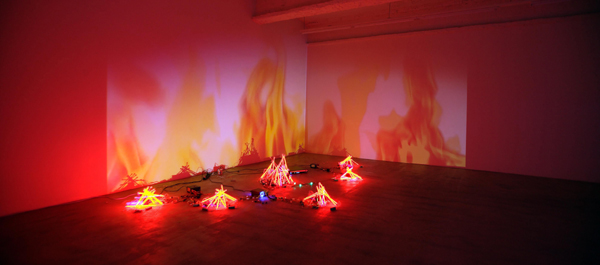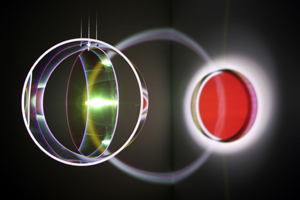This is an archive of the ArtCat Zine, 2007-2009. Please visit our new project, IDIOM.
Icelandics

From Another Shore: Recent Icelandic Art
May 1 - August 15, 2008
Scandinavia House - 58 Park Avenue
Initially, the most noticeable works at the gallery at Scandinavia House are the pieces comprising Haul. Five tiny models scattered around the floor envision lightly populated landscapes; viewed from above, the sculptures give visitors the effect of the ground viewed from an airplane window. Referencing the artist’s own tendency to move around the world, the landscapes are built within cargo crates sized to fit them; the crates themselves look haphazardly opened and ready to be packed back up at any moment. Their creator, Katrín Sigurðardóttir, is from Iceland, as are all the artists featured in From Another Shore – studies have brought her to San Francisco and New Jersey, and in that way she exemplifies a part of the premise behind the organization of the show.
Halldór Björn Runólfsson, the director of Iceland’s National Gallery, curated From Another Shore in conjunction with Scandinavia House, paying close attention to the unique position of Iceland’s artists in the global art market. He posits that nature, particularly landscape, is behind all contemporary Icelandic art, whether or not its presence is visually manifested in the resulting work. There is a natural influence visible in most of the art in From Another Shore - landscape in sculpture, landscape in photography, moss on embroidery - but the inspiration provided by Iceland's terrain ends there. Runólfsson, in his notes on the show, points out the necessary tendency of the island’s artists to study or live and work abroad. Put into the larger frame of the global art world, it seems they’re practically required to make a presence for themselves elsewhere in order to achieve success. What's most notable is the point Runólfsson makes with the show; the significance is the artists' departures from Iceland rather than their resultant emigration to whatever destination. What Runólfsson achieves is a successful reconcilation between what his artists draw from Iceland, specifically, and from various diverse urban environments.

Ólafur Elíasson, the installation man of the hour in this city, may best represent that phenomenon. At Scandinavia House he shows a small, precise version of his artificially-lit, gently rotating sculptures that play with light in a removed space, and a vivid, scaled-down version of his photograph assemblies, Green River Series. Elíasson studied at Copenhagen’s Royal Academy of Arts and now works in Berlin, yet Green River Series, comprised of pictures of landscapes, is purely Icelandic.
However, rather than examine this national necessity of literally outsourcing one's self, or at least, one’s shows, in order to become deservedly recognized, it is better to note it as fact and commend Runólfsson for bringing all together these particular, far-away artists to Scandinavia House. The show is as thoughtfully curated as any special exhibit in a small museum, and has the added responsibility of standing alone in the space and far from its parent institution (Iceland’s National Gallery.) The most successful and telling aspect of From Another Shore is not just the manner in which it is put together, but the fact that the work, in addition to its beauty or likeableness or unique inspirations, has the mark of an interesting brand of humor. Take Margrét H. Blöndal’s Sugar: a crystallized, layered, foot-high rock slowly dripping syrup onto the gallery floor. This gigantic lump of sugar is sufficiently good-looking, and visually interesting enough in its gradual, unstoppable change, that it doesn’t subvert the laughter of the observer watching it quietly self-destruct. However, it will disappear, eventually, and that's distressing enough to complicate any lighthearted observation.
ZINE
HOME
TIPS / COMMENTS
CATEGORIES
CONTRIBUTORS
- Greg Afinogenov
- B. Blagojevic
- Adda Birnir
- Susannah Edelbaum
- Julie Fishkin
- Paddy Johnson
- Jessica Loudis
- Christopher Reiger
- Andrew Robinson
- Peter J. Russo
- Blythe Sheldon
- S.C.Squibb
- Hrag Vartanian
